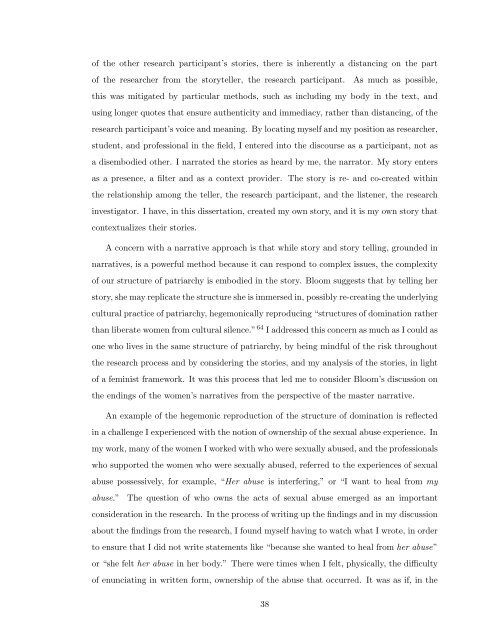Women's Narratives of Healing from the Effects of Child Sexual Abuse
Women's Narratives of Healing from the Effects of Child Sexual Abuse
Women's Narratives of Healing from the Effects of Child Sexual Abuse
Create successful ePaper yourself
Turn your PDF publications into a flip-book with our unique Google optimized e-Paper software.
<strong>of</strong> <strong>the</strong> o<strong>the</strong>r research participant’s stories, <strong>the</strong>re is inherently a distancing on <strong>the</strong> part<br />
<strong>of</strong> <strong>the</strong> researcher <strong>from</strong> <strong>the</strong> storyteller, <strong>the</strong> research participant. As much as possible,<br />
this was mitigated by particular methods, such as including my body in <strong>the</strong> text, and<br />
using longer quotes that ensure au<strong>the</strong>nticity and immediacy, ra<strong>the</strong>r than distancing, <strong>of</strong> <strong>the</strong><br />
research participant’s voice and meaning. By locating myself and my position as researcher,<br />
student, and pr<strong>of</strong>essional in <strong>the</strong> field, I entered into <strong>the</strong> discourse as a participant, not as<br />
a disembodied o<strong>the</strong>r. I narrated <strong>the</strong> stories as heard by me, <strong>the</strong> narrator. My story enters<br />
as a presence, a filter and as a context provider. The story is re- and co-created within<br />
<strong>the</strong> relationship among <strong>the</strong> teller, <strong>the</strong> research participant, and <strong>the</strong> listener, <strong>the</strong> research<br />
investigator. I have, in this dissertation, created my own story, and it is my own story that<br />
contextualizes <strong>the</strong>ir stories.<br />
A concern with a narrative approach is that while story and story telling, grounded in<br />
narratives, is a powerful method because it can respond to complex issues, <strong>the</strong> complexity<br />
<strong>of</strong> our structure <strong>of</strong> patriarchy is embodied in <strong>the</strong> story. Bloom suggests that by telling her<br />
story, she may replicate <strong>the</strong> structure she is immersed in, possibly re-creating <strong>the</strong> underlying<br />
cultural practice <strong>of</strong> patriarchy, hegemonically reproducing “structures <strong>of</strong> domination ra<strong>the</strong>r<br />
than liberate women <strong>from</strong> cultural silence.” 64 I addressed this concern as much as I could as<br />
one who lives in <strong>the</strong> same structure <strong>of</strong> patriarchy, by being mindful <strong>of</strong> <strong>the</strong> risk throughout<br />
<strong>the</strong> research process and by considering <strong>the</strong> stories, and my analysis <strong>of</strong> <strong>the</strong> stories, in light<br />
<strong>of</strong> a feminist framework. It was this process that led me to consider Bloom’s discussion on<br />
<strong>the</strong> endings <strong>of</strong> <strong>the</strong> women’s narratives <strong>from</strong> <strong>the</strong> perspective <strong>of</strong> <strong>the</strong> master narrative.<br />
An example <strong>of</strong> <strong>the</strong> hegemonic reproduction <strong>of</strong> <strong>the</strong> structure <strong>of</strong> domination is reflected<br />
in a challenge I experienced with <strong>the</strong> notion <strong>of</strong> ownership <strong>of</strong> <strong>the</strong> sexual abuse experience. In<br />
my work, many <strong>of</strong> <strong>the</strong> women I worked with who were sexually abused, and <strong>the</strong> pr<strong>of</strong>essionals<br />
who supported <strong>the</strong> women who were sexually abused, referred to <strong>the</strong> experiences <strong>of</strong> sexual<br />
abuse possessively, for example, “Her abuse is interfering,” or “I want to heal <strong>from</strong> my<br />
abuse.” The question <strong>of</strong> who owns <strong>the</strong> acts <strong>of</strong> sexual abuse emerged as an important<br />
consideration in <strong>the</strong> research. In <strong>the</strong> process <strong>of</strong> writing up <strong>the</strong> findings and in my discussion<br />
about <strong>the</strong> findings <strong>from</strong> <strong>the</strong> research, I found myself having to watch what I wrote, in order<br />
to ensure that I did not write statements like “because she wanted to heal <strong>from</strong> her abuse”<br />
or “she felt her abuse in her body.” There were times when I felt, physically, <strong>the</strong> difficulty<br />
<strong>of</strong> enunciating in written form, ownership <strong>of</strong> <strong>the</strong> abuse that occurred. It was as if, in <strong>the</strong><br />
38
















